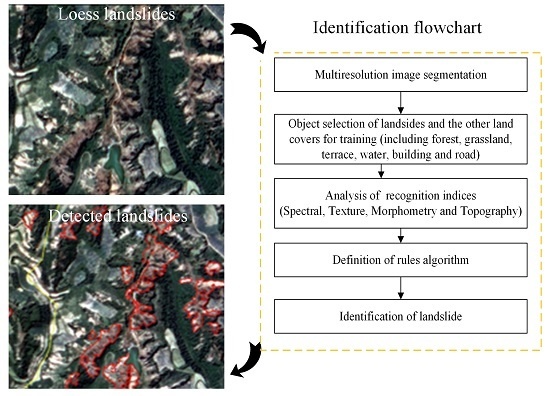Loess Landslide Inventory Map Based on GF-1 Satellite Imagery
Abstract
:1. Introduction
2. Materials and Methods
2.1. Study Areas
2.2. Proposed Approach
2.2.1. Data Sources and Processing
2.2.2. Object-Oriented Analysis and Segmentation Techniques
2.2.3. Identification Indices of Loess Landslides
2.2.4. Accuracy Assessment
3. Results
3.1. Identification of Spectral, Texture and Morphometric Characteristics of Loess Landslides
3.2. Topography Characteristics of Loess Landslides
3.3. Rules for the Discrimination of Landslides and Other Land Covers
- (1)
- The values of NDVI are greater than 0.13 and less than 0.34. Forest, grassland and water areas can be completely removed.
- (2)
- The spectral values of the blue band were between 0.06 and 0.10. Elongation was higher than 1.08 and lower than 2.48. In addition, roundness was restricted to within 0.24–0.62. Considerable portions of roads could be distinguished.
- (3)
- The spectral values of the near-infrared band can range from 0.14 to 0.25, and the elevation can vary from 1100 to 1250. Most areas containing terraces and buildings can be discriminated from landslide candidates.
- (4)
- The variance of the NDVI texture was less than 0.0025. A portion of the buildings can be further removed.
- (5)
- A cleanup operation was performed to eliminate non-landslide areas occupying parts of an object.
- (6)
- Finally, hillslope landslides were separated from loess flows using the extracted gullies.
3.4. Detected Loess Landslides and Accuracy Assessment
4. Discussion
5. Conclusions
Acknowledgments
Author Contributions
Conflicts of Interest
References
- Wu, X.; Chen, X.; Zhan, F.B.; Hong, S. Global research trends in landslides during 1991–2014: A bibliometric analysis. Landslides 2015, 12, 1215–1226. [Google Scholar] [CrossRef]
- Sassa, K.; Tsuchiya, S.; Fukuoka, H.; Mikos, M.; Doan, L. Landslides: Review of achievements in the second 5-year period (2009–2013). Landslides 2015, 12, 213–223. [Google Scholar] [CrossRef]
- Xu, C.; Xu, X.W.; Yu, G.H. Landslides triggered by slipping-fault-generated earthquake on a plateau: An example of the 14 april 2010, ms 7.1, Yushu, China Earthquake. Landslides 2013, 10, 421–431. [Google Scholar] [CrossRef]
- Vorpahl, P.; Elsenbeer, H.; Märker, M.; Schröder, B. How can statistical models help to determine driving factors of landslides? Ecol. Model. 2012, 239, 27–39. [Google Scholar] [CrossRef]
- Gassner, C.; Promper, C.; Beguería, S.; Glade, T. Climate change impact for spatial landslide susceptibility. In Engineering Geology for Society and Territory; Lollino, G., Manconi, A., Clague, J., Shan, W., Chiarle, M., Eds.; Springer: Cham, Switzerland, 2015; pp. 429–433. [Google Scholar]
- Buchroithner, M.F.; Changyao, W.; Hengzhang, L. Landslide Erosion in the Loess Plateau (P.R. China) by Remote Sensing. In Proceedings of the International Symposium on Geological Hazards, Beijing, China, 20–25 October 1991; pp. 550–554. [Google Scholar]
- Wang, G.; Li, T.; Xing, X.; Zou, Y. Research on loess flow-slides induced by rainfall in July 2013 in YAN’AN, NW China. Environ. Earth Sci. 2015, 73, 7933–7944. [Google Scholar] [CrossRef]
- Yang, W.; Shen, L.; Shi, P. Mapping landslide risk of the world. In World Atlas of Natural Disaster Risk; Springer: Berlin/Heidelberg, Germany, 2015; pp. 57–66. [Google Scholar]
- Kirschbaum, D.; Stanley, T.; Zhou, Y. Spatial and temporal analysis of a global landslide catalog. Geomorphology 2015, 249, 4–15. [Google Scholar] [CrossRef]
- Pradhan, B.; Buchroithner, M.F. Terrigenous Mass Movements: Detection, Modelling, Early Warning and Mitigation Using Geoinformation Technology; Springer: New York, NY, USA, 2012. [Google Scholar]
- Chen, W.; Xie, X.; Wang, J.; Pradhan, B.; Hong, H.; Bui, D.T.; Duan, Z.; Ma, J. A comparative study of logistic model tree, random forest, and classification and regression tree models for spatial prediction of landslide susceptibility. Catena 2017, 151, 147–160. [Google Scholar] [CrossRef]
- Mondini, A.C.; Guzzetti, F.; Reichenbach, P.; Rossi, M.; Cardinali, M.; Ardizzone, F. Semi-automatic recognition and mapping of rainfall induced shallow landslides using optical satellite images. Remote Sens. Environ. 2011, 115, 1743–1757. [Google Scholar] [CrossRef]
- Guzzetti, F.; Reichenbach, P.; Ardizzone, F.; Cardinali, M.; Galli, M. Estimating the quality of landslide susceptibility models. Geomorphology 2006, 81, 166–184. [Google Scholar] [CrossRef]
- Martha, T.R.; Kerle, N.; Jetten, V.; van Westen, C.J.; Kumar, K.V. Characterising spectral, spatial and morphometric properties of landslides for semi-automatic detection using object-oriented methods. Geomorphology 2010, 116, 24–36. [Google Scholar] [CrossRef]
- Rau, J.Y.; Jhan, J.P.; Rau, R.J. Semiautomatic object-oriented landslide recognition scheme from multisensor optical imagery and DEM. IEEE Trans. Geosci. Remote 2014, 52, 1336–1349. [Google Scholar] [CrossRef]
- Moosavi, V.; Talebi, A.; Shirmohammadi, B. Producing a landslide inventory map using pixel-based and object-oriented approaches optimized by TAGUCHI method. Geomorphology 2014, 204, 646–656. [Google Scholar] [CrossRef]
- Huang, R.Q. Some catastrophic landslides since the twentieth century in the southwest of china. Landslides 2009, 6, 69–81. [Google Scholar]
- Plank, S.; Hölbling, D.; Eisank, C.; Friedl, B.; Martinis, S.; Twele, A. Comparing Object-Based Landslide Detection Methods Based on Polarimetric Sar and Optical Satellite Imagery—A Case Study in Taiwan. In Proceedings of the 7th International Workshop on Science and Applications of SAR Polarimetry and Polarimetric Interferometry, POLinSAR 2015, Frascati, Italy, 27–30 January 2015; pp. 27–30. [Google Scholar]
- Hölbling, D.; Friedl, B.; Eisank, C. Object-based change detection for landslide monitoring based on spot imagery. In Proceedings of the GU General Assembly 2014, Vienna, Austria, 27 April–2 May 2014. [Google Scholar]
- Danneels, G.; Pirard, E.; Havenith, H.B. Automatic Landslide Detection from Remote Sensing Images Using Supervised Classification Methods. In Proceedings of the IEEE International Geoscience and Remote Sensing Symposium, Barcelona, Spain, 23–27 July 2007. [Google Scholar]
- Wan, S.; Lei, T.; Chou, T. A landslide expert system: Image classification through integration of data mining approaches for multi-category analysis. Int. J. Geogr. Inf. Sci. 2012, 26, 747–770. [Google Scholar] [CrossRef]
- Bui, D.T.; Tuan, T.A.; Klempe, H.; Pradhan, B.; Revhaug, I. Spatial prediction models for shallow landslide hazards: A comparative assessment of the efficacy of support vector machines, artificial neural networks, kernel logistic regression, and logistic model tree. Landslides 2015, 13, 361–378. [Google Scholar]
- Alimohammadlou, Y.; Najafi, A.; Gokceoglu, C. Estimation of rainfall-induced landslides using ANN and fuzzy clustering methods: A case study in saeen slope, Azerbaijan Province, Iran. Catena 2014, 120, 149–162. [Google Scholar] [CrossRef]
- Lahousse, T.; Chang, K.T.; Lin, Y.H. Landslide mapping with multi-scale object-based image analysis—A case study in the Baichi Watershed, Taiwan. Nat. Hazards Earth Syst. Sci. 2011, 11, 2715–2726. [Google Scholar] [CrossRef]
- Singleton, A.; Li, Z.; Hoey, T.; Muller, J.P. Evaluating sub-pixel offset techniques as an alternative to d-insar for monitoring episodic landslide movements in vegetated terrain. Remote Sens. Environ. 2014, 147, 133–144. [Google Scholar] [CrossRef]
- Lu, P.; Stumpf, A.; Kerle, N.; Casagli, N. Object-oriented change detection for landslide rapid mapping. IEEE Geosci. Remote Sens. Lett. 2011, 8, 701–705. [Google Scholar] [CrossRef]
- Stumpf, A.; Kerle, N. Object-oriented mapping of landslides using random forests. Remote Sens. Environ. 2011, 115, 2564–2577. [Google Scholar] [CrossRef]
- Li, Z.; Shi, W.; Myint, S.W.; Lu, P.; Wang, Q. Semi-automated landslide inventory mapping from bitemporal aerial photographs using change detection and level set method. Remote Sens. Environ. 2016, 175, 215–230. [Google Scholar] [CrossRef]
- Martha, T.R.; van Westen, C.J.; Kerle, N.; Jetten, V.; Kumar, K.V. Landslide hazard and risk assessment using semi-automatically created landslide inventories. Geomorphology 2013, 184, 139–150. [Google Scholar] [CrossRef]
- Wei, Y.; Jin, J.; Wang, Q. Impacts of natural disasters and disaster risk management in China: The case of China’s experience in the wenchuan earthquake. In Resilience and Recovery in Asian Disasters; Aldrich, D.P., Oum, S., Sawada, Y., Eds.; Springer: London, UK, 2015; pp. 287–307. [Google Scholar]
- Chen, X.L.; Yu, L.; Wang, M.M.; Lin, C.X.; Liu, C.G.; Li, J.Y. Brief communication: Landslides triggered by the m-s=7.0 Lushan Earthquake, China. Nat. Hazard Earth Syst. 2014, 14, 1257–1267. [Google Scholar] [CrossRef]
- Liu, F.; Li, J.; Yang, S. Landslide erosion associated with the wenchuan earthquake in the minjiang river watershed: Implication for landscape evolution of the Longmen Shan, Eastern Tibetan Plateau. Nat. Hazards 2015, 76, 1911–1926. [Google Scholar] [CrossRef]
- Chen, Q.; Cheng, H.Q.; Yang, Y.H.; Liu, G.X.; Liu, L.Y. Quantification of mass wasting volume associated with the giant landslide daguangbao induced by the 2008 Wenchuan Earthquake from persistent scatterer InSAR. Remote Sens. Environ. 2014, 152, 125–135. [Google Scholar] [CrossRef]
- Tang, C.; Rengers, N.; van Asch, T.W.J.; Yang, Y.H.; Wang, G.F. Triggering conditions and depositional characteristics of a disastrous debris flow event in Zhouqu City, Gansu Province, Northwestern China. Nat. Hazard Earth Syst. 2011, 11, 2903–2912. [Google Scholar] [CrossRef]
- Xu, L.; Dai, F.; Tu, X.; Tham, L.; Zhou, Y.; Iqbal, J. Landslides in a loess platform, North-west China. Landslides 2014, 11, 993–1005. [Google Scholar] [CrossRef]
- Sun, W.Y.; Shao, Q.Q.; Liu, J.Y.; Zhai, J. Assessing the effects of land use and topography on soil erosion on the Loess plateau in China. Catena 2014, 121, 151–163. [Google Scholar] [CrossRef]
- Sun, W.; Zhu, H.; Guo, S. Soil organic carbon as a function of land use and topography on the Loess Plateau of China. Ecol. Eng. 2015, 83, 249–257. [Google Scholar] [CrossRef]
- ENVI. Atmospheric Correction Module. QUAC and FLAASH User’s Guide. Available online: http://www.harrisgeospatial.com/portals/0/pdfs/envi/flaash_module.pdf (accessed on 4 January 2017).
- Laben, C.A.; Brower, B.V. Process for Enhancing the Spatial Resolution of Multispectral Imagery using Pan-Sharpening. U.S. Patent 6011875, 4 January 2000. [Google Scholar]
- Hutchinson, M. Anudem version 5.3, user guide. In Canberra: Fenner School of Environment and Society; Australian National University: Acton, Australia, 2011. [Google Scholar]
- Yourdon, E. Object-Oriented Systems Design: An Integrated Approach; Prentice Hall: Upper Saddle River, NJ, USA, 1993. [Google Scholar]

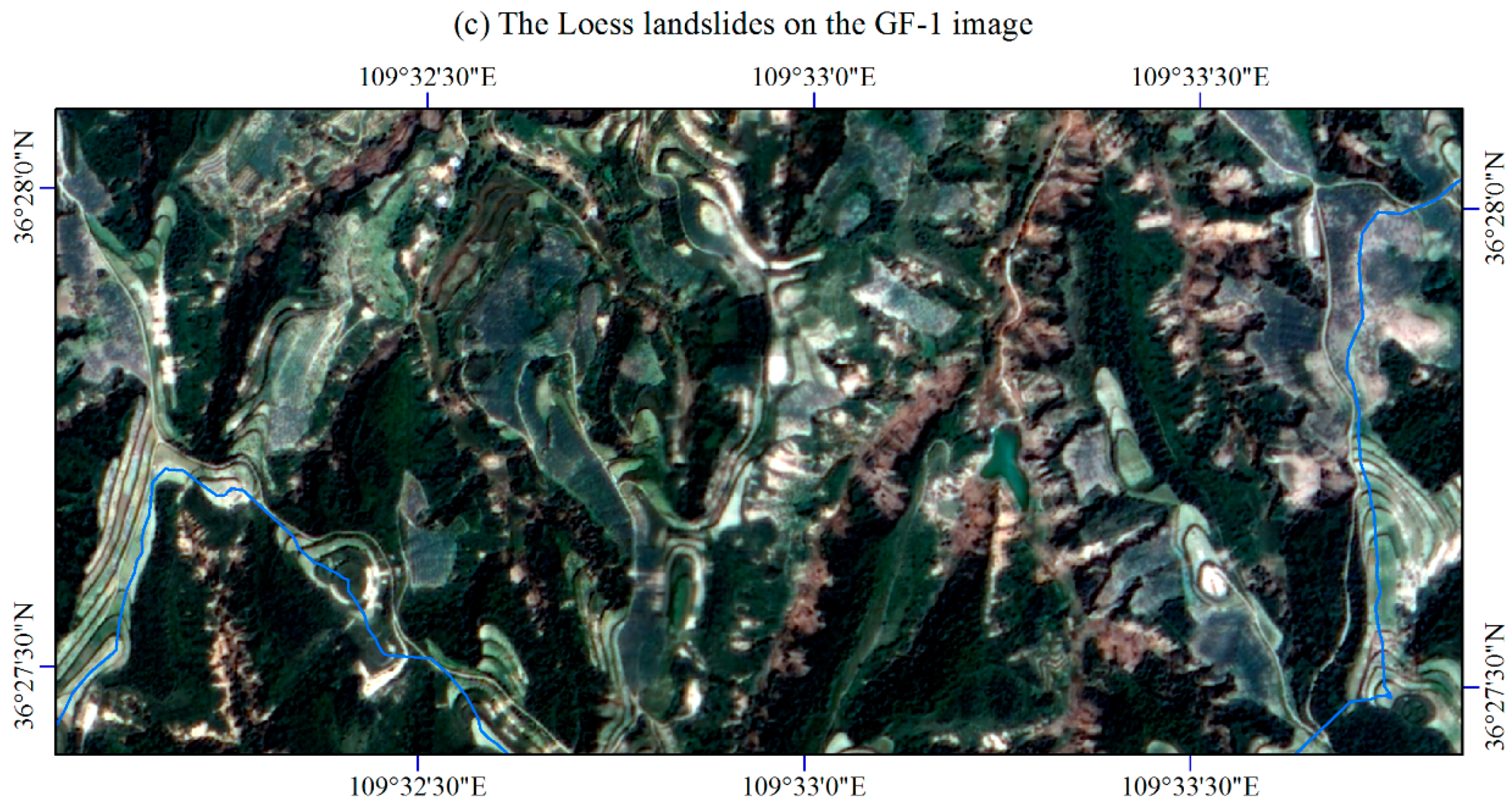
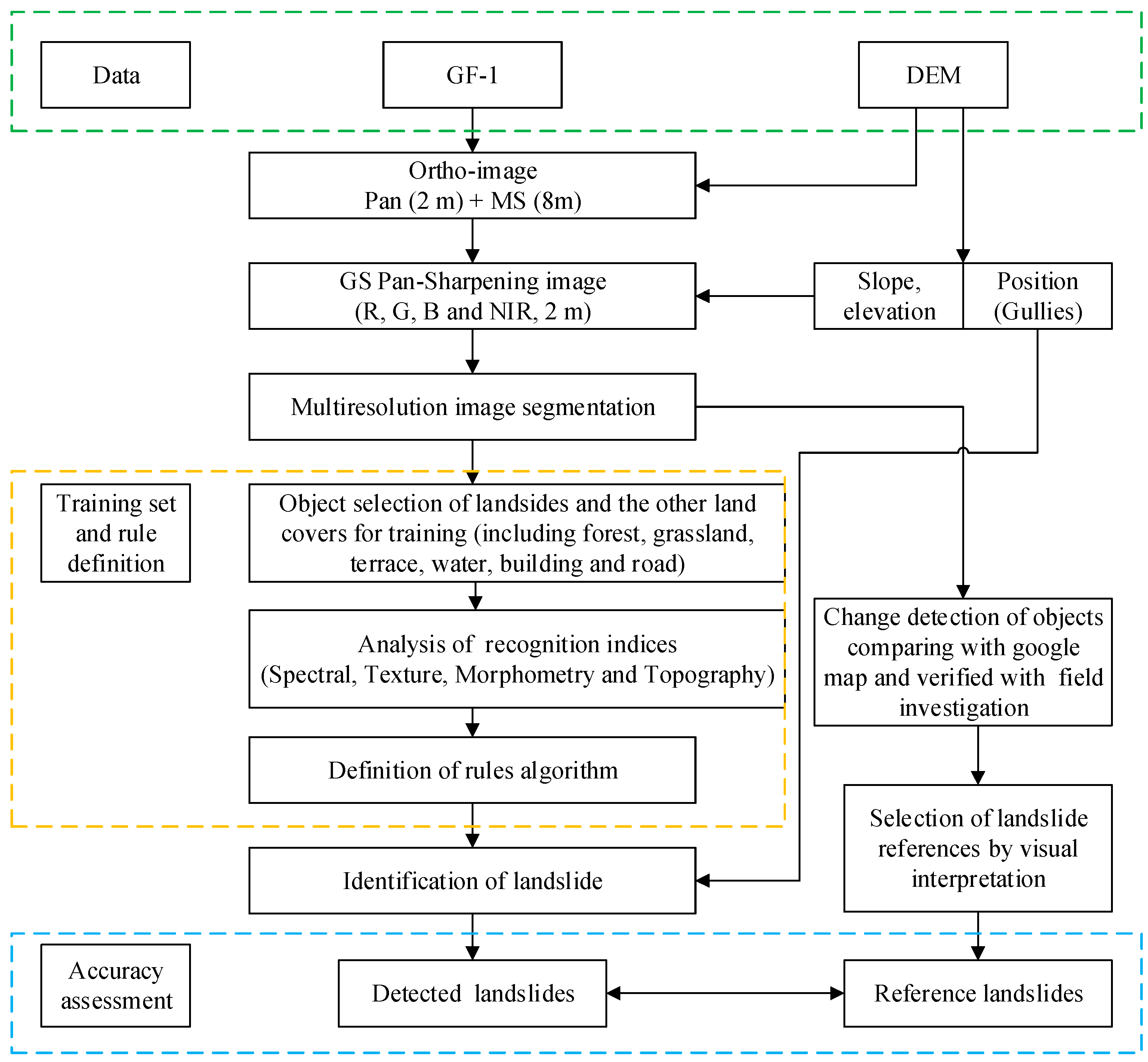
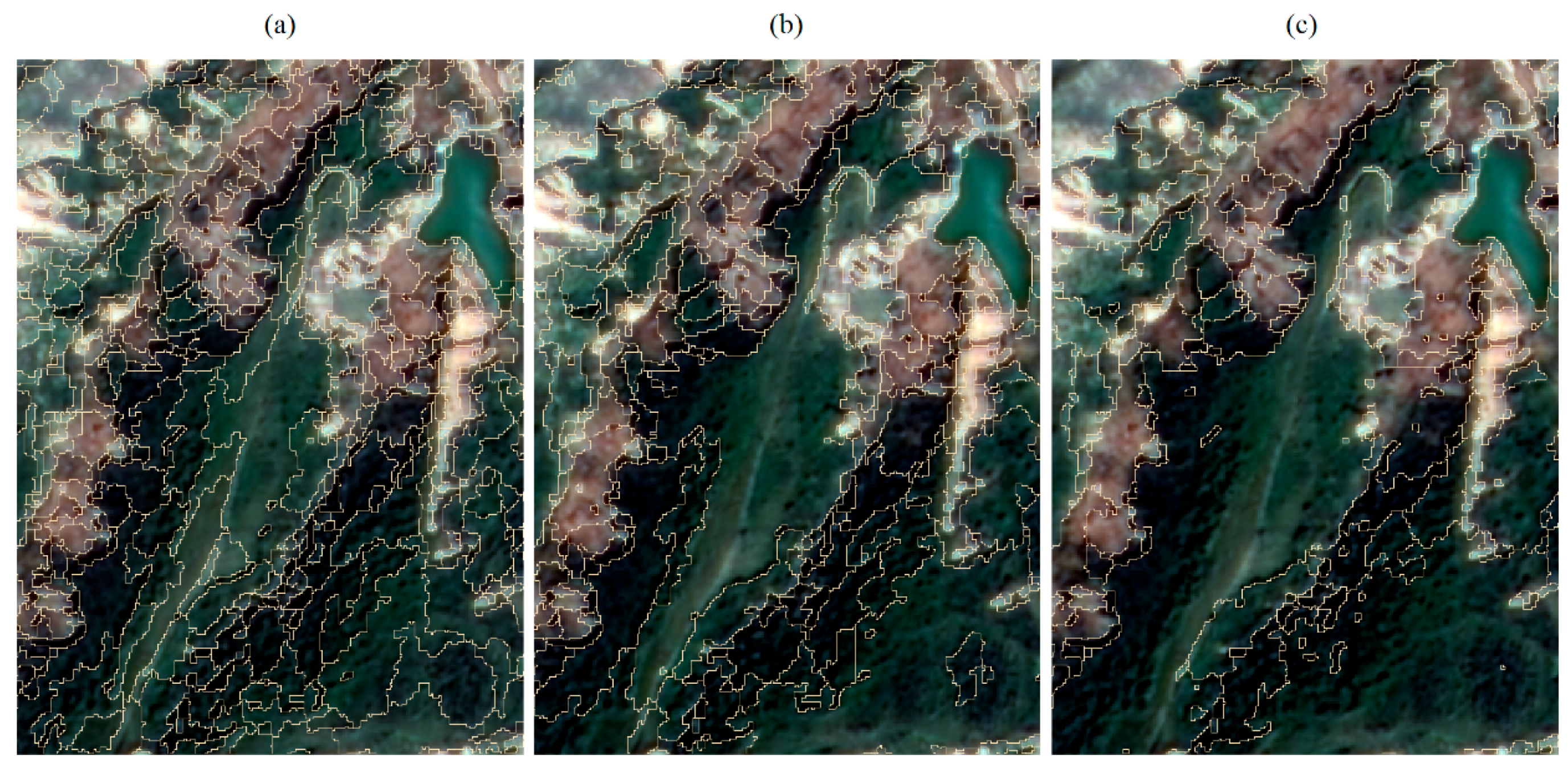

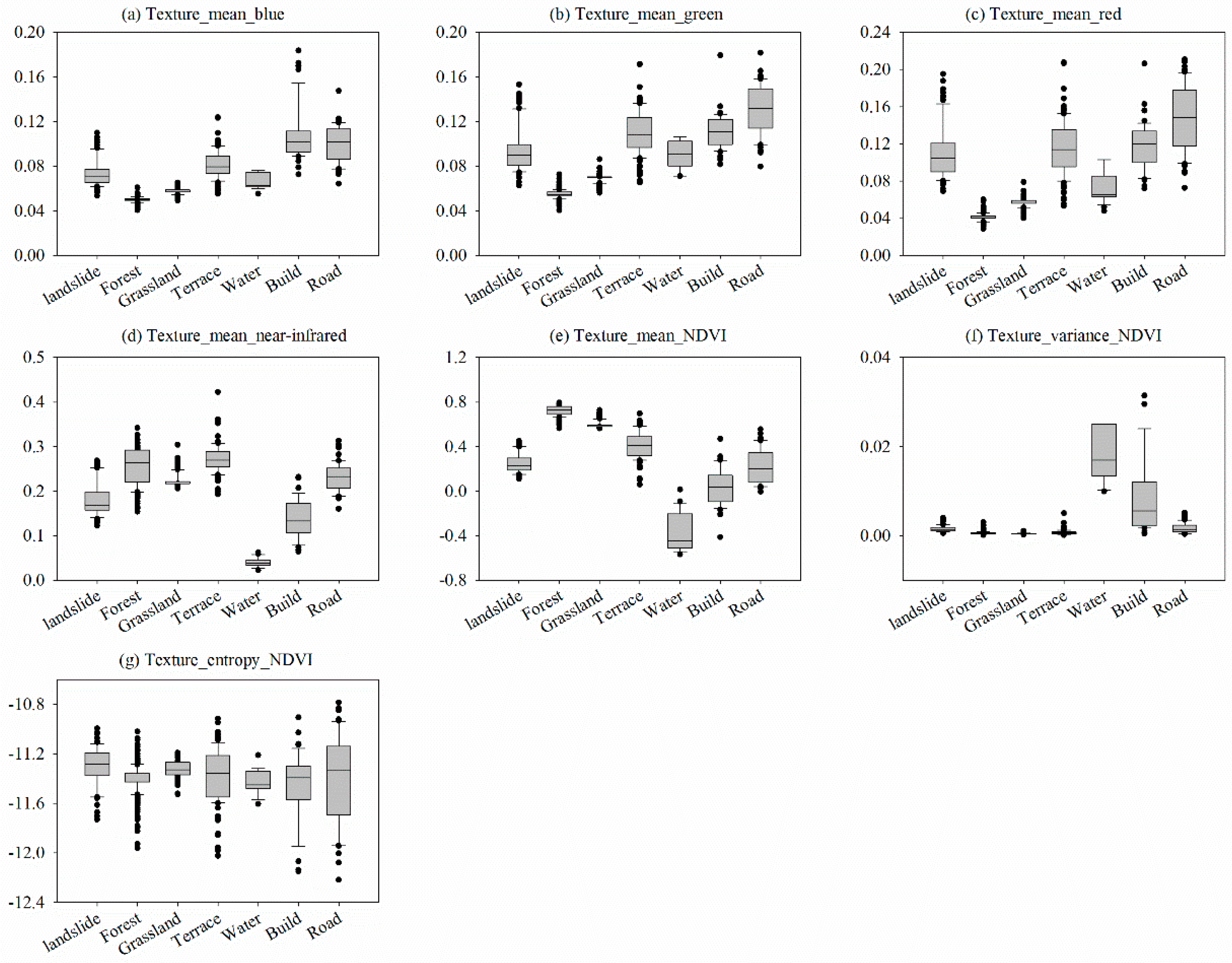

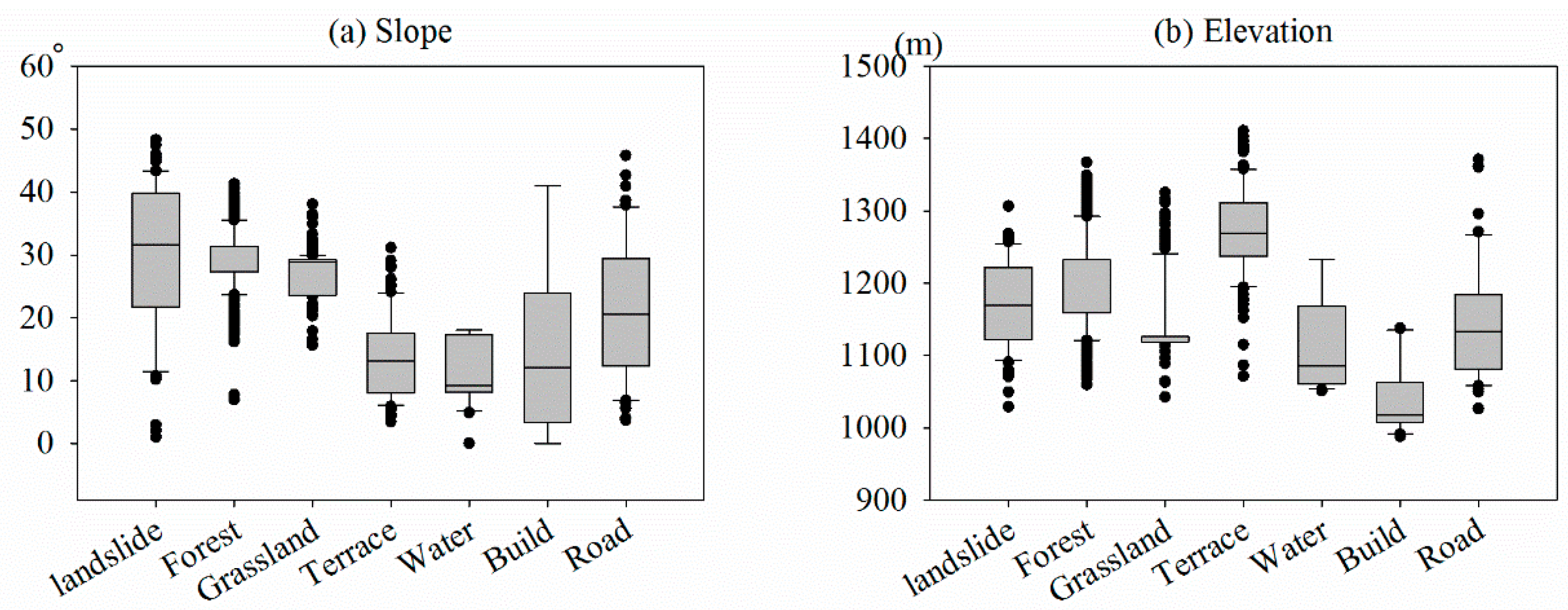
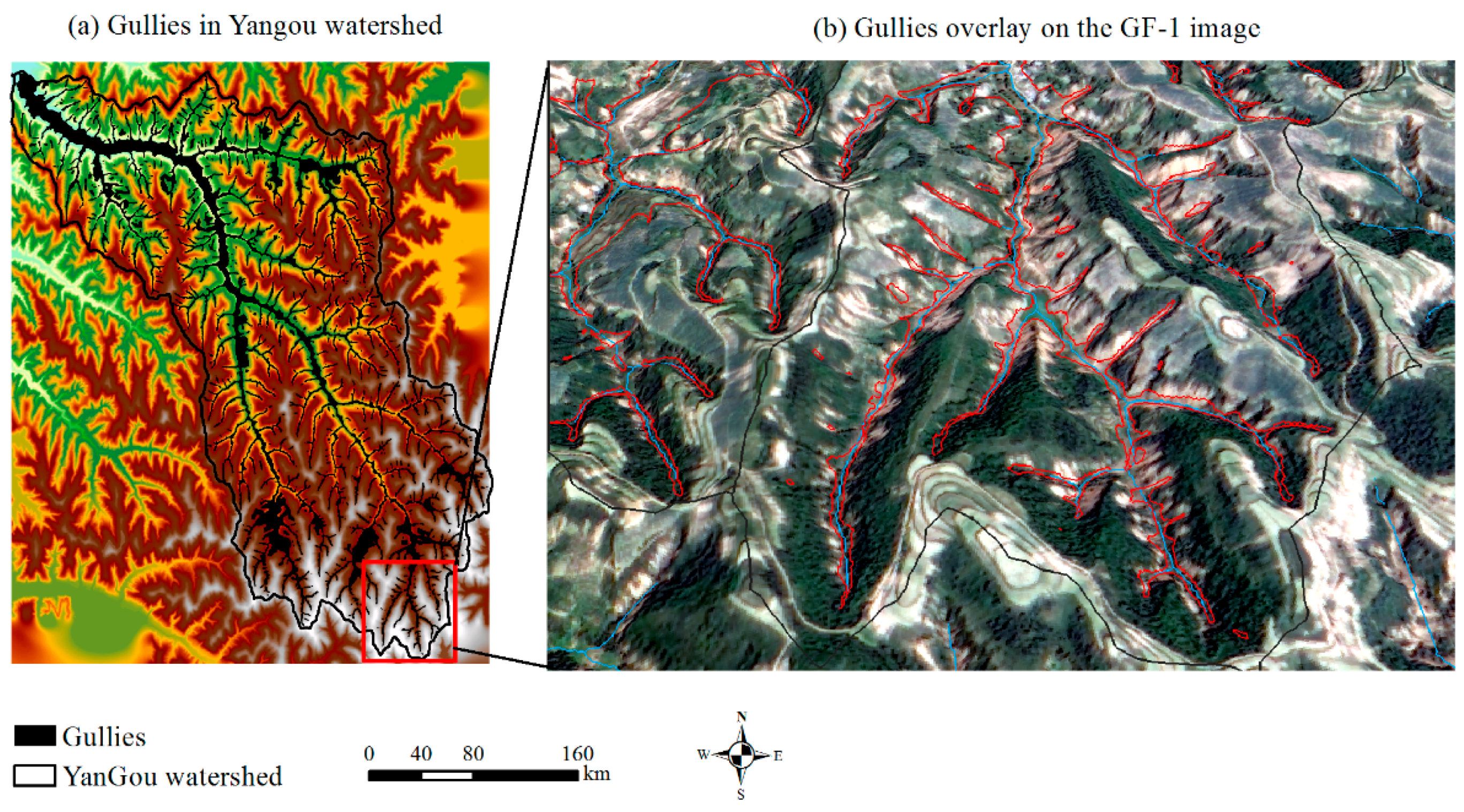
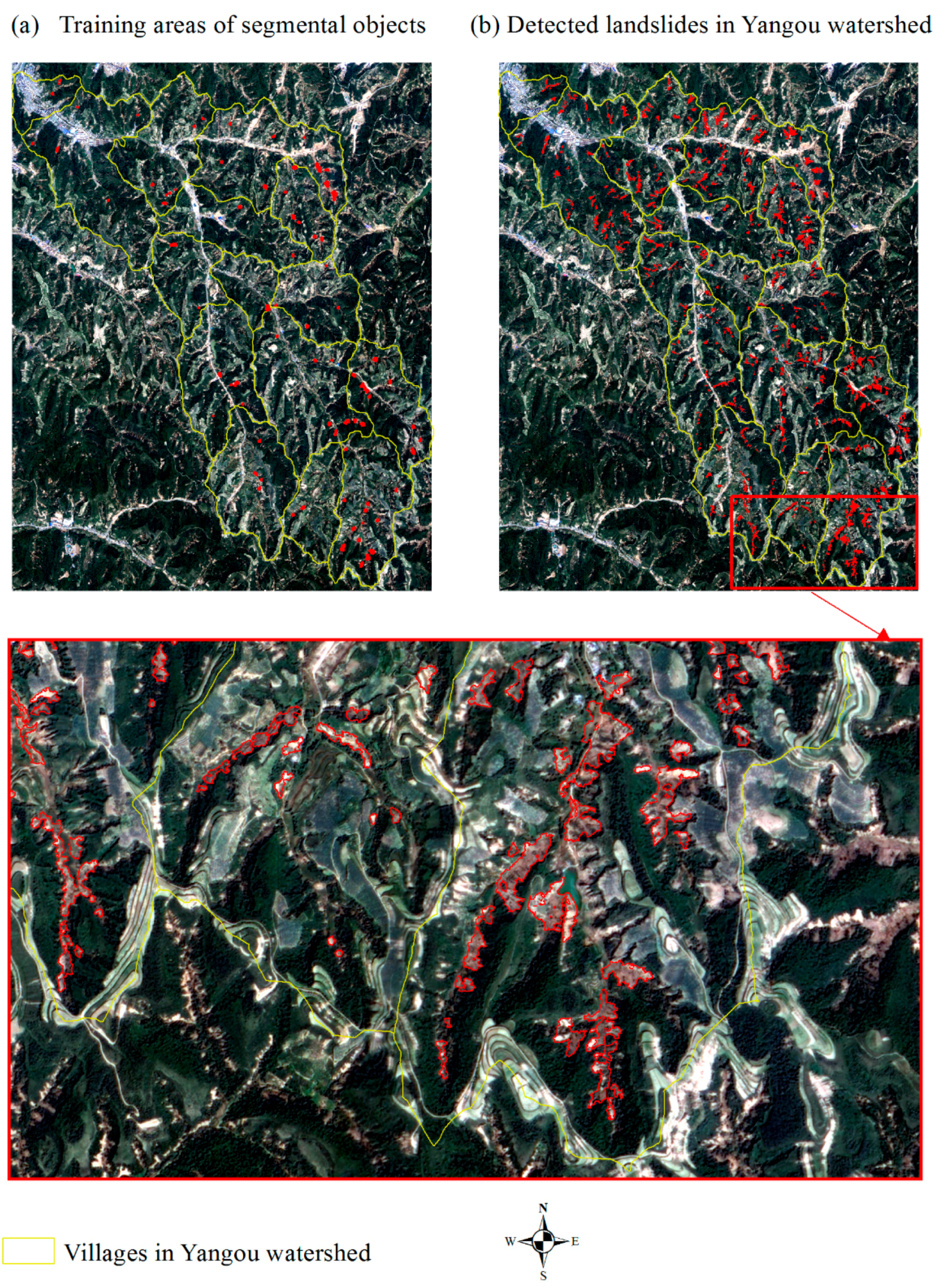
| Types | Attributes | Descriptions |
|---|---|---|
| Spectral | Reflectance | Mean of pixels comprising a segmented object in the blue, green, red or near-infrared band |
| NDVI | The ratio of the difference between near-infrared and red reflectance to their sum as an indicator of vegetation greenness | |
| HIS | Hue, saturation, and intensity created using a color space transformation from red-green-blue color model (RGB) to hue- intensity-saturation (HIS) | |
| Texture | Mean | Average of the pixels comprising a segmented object inside the kernel |
| Variance | Average variance of the pixels comprising a segmented object inside the kernel | |
| Entropy | Average entropy of the pixels comprising a segmented object inside the kernel | |
| Morphometry | Area | Total area of the polygon, minus the area of the holes |
| Length | The combined length of all boundaries of the polygon, including the boundaries of the holes | |
| Compactness | A shape measure that indicates the compactness of the polygon. A circle is the most compact shape, with a value of 1/π. The compactness value of a square is 1/2(sqrt(π)). Sqrt refers to square root calculations | |
| Solidity | A shape measure that compares the area of the polygon to the area of a convex hull surrounding the polygon. The solidity value for a convex polygon with no holes is 1.0, and this value for a concave polygon is less than 1.0 | |
| Roundness | A shape measure that compares the area of the polygon to the square of the maximum diameter of the polygon. The roundness value for a circle is 1, and the value for a square is 4/π | |
| Elongation | A shape measure that indicates the ratio of the major axis of the polygon to the minor axis of the polygon. The elongation value for a square is 1.0, and the value for a rectangle is greater than 1.0 | |
| Rectangular_Fit | A shape measure that indicates how well the shape is described by a rectangle. This attribute compares the area of the polygon to the area of the oriented bounding box enclosing the polygon. The rectangular fit value for a rectangle is 1.0, and the value for a non-rectangular shape is less than 1.0 |
| Types | Variables | Landslides | Forest | Grassland | Terrace | Water | Building | Road |
|---|---|---|---|---|---|---|---|---|
| Spectral | NDVI | 0.13–0.34 | 0.67–0.78 | 0.56–0.68 | <0 | |||
| Blue band | 0.06–0.10 | 0.09–0.12 | ||||||
| Near infrared band | 0.14–0.25 | 0.23–0.33 | 0.06–0.18 | |||||
| Texture | Mean of texture | 0.14–0.25 | 0.24–0.31 | |||||
| Variance of texture | <0.0025 | 0.0015–0.024 | ||||||
| Morphometry | Elongation | 1.08–2.48 | 1.40–8.35 | |||||
| Roundness | 0.24–0.62 | 0.06–0.30 | ||||||
| Topography | Slope | 10–45 | <25 | |||||
| Elevation | 1100–1250 | >1200 | <1130 |
| No. | SITE Name | Area (km2) | Training Area (km2) | Training Area (%) | Landslide References (km2) | Detected Landslides (km2) | User Accuracy (UA) | Producer Accuracy (PA) | Branching Factor (BF) | Miss Factor (MF) | Quality Percentage (QP) | Kappa Index |
|---|---|---|---|---|---|---|---|---|---|---|---|---|
| 1 | YangJiaPan | 3.85 | 0.024 | 0.63 | 0.27 | 0.25 | 0.98 | 0.96 | 0.02 | 0.04 | 0.95 | 0.97 |
| 2 | ShiTouGou | 2.13 | 0.003 | 0.14 | 0.06 | 0.05 | 0.93 | 0.95 | 0.08 | 0.05 | 0.89 | 0.94 |
| 3 | MaTa | 3.77 | 0.004 | 0.10 | 0.15 | 0.14 | 0.96 | 0.93 | 0.04 | 0.07 | 0.90 | 0.94 |
| 4 | NanZhuangHe | 5.09 | 0.010 | 0.20 | 0.21 | 0.18 | 0.99 | 0.86 | 0.01 | 0.16 | 0.85 | 0.92 |
| 5 | SiChaPu | 3.42 | 0.004 | 0.10 | 0.18 | 0.15 | 0.98 | 0.86 | 0.02 | 0.17 | 0.84 | 0.91 |
| 6 | ShaoYuanLiang | 2.91 | 0.020 | 0.70 | 0.22 | 0.21 | 0.97 | 0.97 | 0.03 | 0.03 | 0.94 | 0.97 |
| 7 | WuZhaoYuan | 4.85 | 0.024 | 0.49 | 0.40 | 0.33 | 0.99 | 0.82 | 0.01 | 0.21 | 0.82 | 0.89 |
| 8 | LaoZhuangPin | 1.36 | 0.002 | 0.17 | 0.03 | 0.02 | 0.87 | 0.83 | 0.15 | 0.20 | 0.74 | 0.85 |
| 9 | JiDanMao | 2.49 | 0.002 | 0.10 | 0.10 | 0.08 | 0.93 | 0.85 | 0.08 | 0.18 | 0.80 | 0.88 |
| 10 | QiuGou | 3.82 | 0.005 | 0.12 | 0.11 | 0.10 | 0.88 | 0.97 | 0.14 | 0.03 | 0.86 | 0.92 |
| 11 | KangKeLao | 2.96 | 0.002 | 0.06 | 0.06 | 0.06 | 0.92 | 0.94 | 0.09 | 0.07 | 0.86 | 0.93 |
| 12 | ZhaoZhuang | 5.74 | 0.003 | 0.05 | 0.25 | 0.24 | 0.99 | 0.94 | 0.01 | 0.06 | 0.94 | 0.97 |
| 13 | LiuLin | 1.15 | 0.001 | 0.10 | 0.02 | 0.02 | 0.88 | 1.00 | 0.14 | 0.00 | 0.88 | 0.94 |
| 14 | MiaoHe | 2.28 | 0.005 | 0.20 | 0.09 | 0.08 | 0.98 | 0.97 | 0.02 | 0.03 | 0.95 | 0.97 |
| 15 | QiuShuTa | 1.80 | 0.008 | 0.45 | 0.15 | 0.14 | 0.97 | 0.89 | 0.03 | 0.12 | 0.87 | 0.92 |
| Total for YanGou | 47.63 | 0.117 | 3.62 | 2.30 | 2.05 | 0.97 | 0.91 | 0.03 | 0.10 | 0.88 | 0.93 | |
© 2017 by the authors. Licensee MDPI, Basel, Switzerland. This article is an open access article distributed under the terms and conditions of the Creative Commons Attribution (CC BY) license (http://creativecommons.org/licenses/by/4.0/).
Share and Cite
Sun, W.; Tian, Y.; Mu, X.; Zhai, J.; Gao, P.; Zhao, G. Loess Landslide Inventory Map Based on GF-1 Satellite Imagery. Remote Sens. 2017, 9, 314. https://doi.org/10.3390/rs9040314
Sun W, Tian Y, Mu X, Zhai J, Gao P, Zhao G. Loess Landslide Inventory Map Based on GF-1 Satellite Imagery. Remote Sensing. 2017; 9(4):314. https://doi.org/10.3390/rs9040314
Chicago/Turabian StyleSun, Wenyi, Yuansheng Tian, Xingmin Mu, Jun Zhai, Peng Gao, and Guangju Zhao. 2017. "Loess Landslide Inventory Map Based on GF-1 Satellite Imagery" Remote Sensing 9, no. 4: 314. https://doi.org/10.3390/rs9040314






